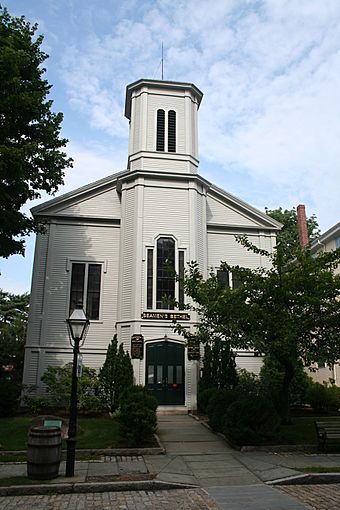Seamen's Bethel facts for kids
Quick facts for kids |
|
|
Seamen's Bethel
|
|
|
U.S. National Historic Landmark District
Contributing Property |
|

Front elevation, 2006
|
|
| Location | New Bedford, Massachusetts |
|---|---|
| Area | New Bedford Historic District |
| Built | 1832 |
| NRHP reference No. | 66000773 |
| Added to NRHP | 1966 |
The Seamen's Bethel is a special chapel in New Bedford, Massachusetts. It is located at 15 Johnny Cake Hill. This chapel was a very important place for sailors. Many sailors would visit it before they went on long voyages at sea.
Contents
History of the Seamen's Bethel
The Seamen's Bethel was built by the New Bedford Port Society. It was finished on May 2, 1832. This building is part of the New Bedford Historic District. This district is a very important historical area.
The chapel was made especially for sailors. Many of these sailors were whalers. They considered it a tradition to visit the chapel before their ships sailed.
Some parts of the building were fixed after a fire in 1866. The names of New Bedford whalers who died are written on the walls. Later, the names of all local fishermen were added too.
James Henry Gooding was a war reporter during the Civil War. He was also a soldier in the 54th Massachusetts Infantry Regiment. He married Ellen Louisa Allen in the Bethel in the summer of 1862.
In 1996, the Seamen's Bethel became part of a larger historical area. This area is called the New Bedford Whaling National Historical Park. The New Bedford Whaling Museum is also part of this park.
The Seamen's Bethel in Moby-Dick
In 1851, Herman Melville wrote his famous book, Moby-Dick. This book tells the story of a white whale. The Seamen's Bethel was made famous in the book. It was called the "Whaleman's Chapel."
Melville wrote about it:
In this same New Bedford there stands a Whaleman's Chapel, and few are the moody fishermen, shortly bound for the Indian Ocean or Pacific, who fail to make a Sunday visit to the spot.
In the story, a chaplain named Father Mapple gives a sermon. He preaches from a pulpit shaped like the front of a ship. People believe that Father Mapple was inspired by a real preacher. This preacher was Father Edward Thompson Taylor. Melville likely heard him speak in Boston.
Melville might also have been inspired by Enoch Mudge. Mudge preached at the Seamen's Bethel on December 27, 1840. Melville was in New Bedford then, waiting to leave on a whaling ship.
The ship-shaped pulpit in the book was Melville's idea. But a copy of it was added to the chapel in 1961. Robert Baker, a boat builder, created it. You can also see the pew where Melville sat when he visited in 1840.
After Moby-Dick was published, the Seamen's Bethel became a symbol. It represented whalers and their history.
Featured in Movies
The Seamen's Bethel has appeared in movies. Shots of the chapel are in the 1922 film Down to the Sea in Ships.
In 1956, director John Huston filmed a scene for his movie Moby Dick. This movie was based on Melville's book. Actors Gregory Peck and Orson Welles were in it. They filmed outside the real Seamen's Bethel. However, the inside scenes were filmed somewhere else. This movie helped bring more visitors to the area.
Images for kids







